How to choose a toilet installation: overview of designs and tips before buying
In addition to traditional toilets, hanging structures have gained great popularity, allowing optimal use of the useful area of the room. And from an aesthetic point of view, they look much better than floor models. Do you agree?
The market of sanitary equipment offers several options, each of which has its own characteristics of installation and operation. We will show you how to choose a toilet installation, what characteristics and parameters are important to consider.
In addition, we describe the operation of the suspension system, designate its pros and cons, and also name the best manufacturers of plumbing. The material contains a video with the advice of an expert on the choice of installations.
The content of the article:
- What is an installation system?
- System components
- Pros and cons of installing a toilet
- Modern models in the interior of the bathrooms
- Types of installation by design
- Overall range of toilet installations
- The best manufacturers of hanging fixtures
- Tips Before Buying Attachments
- Four misconceptions about installing a toilet
- Conclusions and useful video on the topic
What is an installation system?
This name refers to a steel structure that is mounted on a wall. It is a frame on which the necessary fittings, toilet bowl or other types of hygiene devices (sink, bidet) are attached.
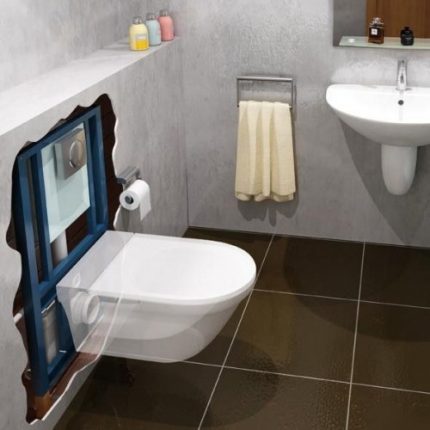
All technical communications are closed with false plasterboard, which gives the interior a nice, neat design. A hanging toilet and a panel with a button for draining remain at a minimum.
System components
A complete kit consists of the following components.
Installation. This important element is a construction made of durable steel, on which a corrosion-resistant coating is usually applied. The hydraulic piping of the toilet bowl and / or other plumbing is fixed to the frame, as well as connecting components (couplings, mounting studs) are installed.
A toilet tank is mounted on the structure, which plays an important role in the operation of the system, since its quality and durability largely depend on this component.
To prevent corrosion and leakage, the tank is usually made of high-quality plastic, and silicone or improved rubber is used to lay the flush valve.
To prevent overflow of water, which can lead to flooding of the apartment, emergency drainage is provided. Manufacturers of modern plumbing comply with European standards, according to which the noise level during operation of the tank should not exceed 17 dB.
Toilet bowl. Modern designs of installation systems, as a rule, are universal: they are suitable for hygienic devices of various brands. In addition to hanging models, frames are also used for some versions of floor fixtures, namely for modifications with a “hidden tank”.
The hygiene products on sale have a variety of colors (from traditional white to black and acid-bright colors), decoration and design. Most models are traditionally made of earthenware or porcelain, however, you can find options from other materials: acrylic, metal, glass.
When choosing a model, it is advisable to pay attention to toilet lid: they can be ordinary or with a "half-lift". The latter option guarantees smooth closing, which prevents plumbing from mechanical damage during sudden collapse.
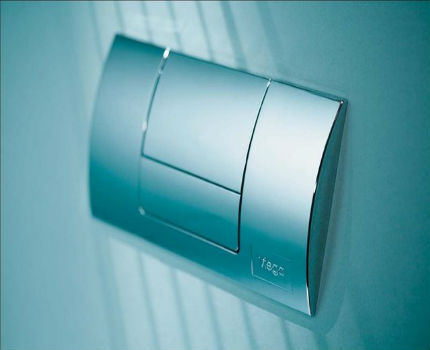
Flush button. A small but important component of the installation system is an external panel with a flush button.
This item may have various modifications:
- with flush-stop mode - in this case, flushing can be stopped by pressing the panel again;
- with two flushing options - economical, involving the draining of half of the tank, and common with a complete drain;
- contactless - driven by infrared rays.
Flush panels can vary significantly in color and design, often they are a real decoration of the toilet or bath.
Pros and cons of installing a toilet
Suspended structures have their advantages and disadvantages.
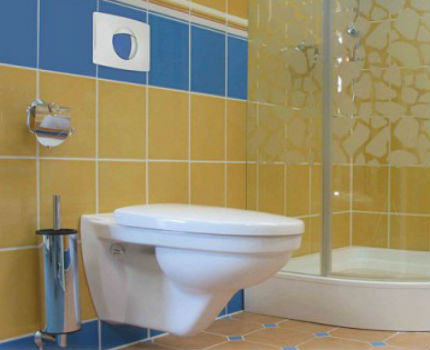
The benefits include the following factors:
- Optimal use of floor space - hanging plumbing takes up less space than ordinary toilets.
- Visual expansion of the room. The small dimensions of hygiene devices, as well as the lack of a tank, allow you to avoid piling up items.
- Aestheticsdue to the fact that all technical details are hidden in the wall.
- Hygiene. The hanging toilet does not have a leg, where bacteria often accumulate. In addition, it leaves the floor completely open, which makes cleaning the room easier.
- Cost-effectiveness. Many models have devices for half draining water, which reduces its consumption.
- Low noise. The use of installation systems allows you to reduce the noise associated with the operation of the tank, because the design has an additional sound-absorbing layer.
- Reliability. Such designs are designed for long-term use. Many manufacturers give a guarantee of 10 years, in reality, models can serve longer.
Obviously, such plumbing devices have many advantages.
The disadvantages of suspended models include:
- Installation of the structure requires care and thoroughness in the work. When installing, it is important to take into account many nuances: the height of the frame, its position in the wall and other characteristics.
- False wall blocks free access to general communications, which may be required, for example, in the case of a centralized replacement of sanitary equipment in the house. If such a need arises, you will have to open the partition, dismantle the cladding or other finishes, and then again repair the damaged area.
- Hanging toilets with an installation system are slightly more expensive than traditional hygiene options.
When choosing plumbing devices, you need to prioritize, assessing how important the above listed are for you features of hanging plumbingand then make an informed choice.
Modern models in the interior of the bathrooms
Various models of wall hung toilets fit perfectly into the interiors of toilets / bathrooms, finished in all kinds of styles - from classic to hi-tech and art deco.
However, before you go to the store, you should think in advance not only of your preferred design, but also the place where the plumbing will be located, since this factor leaves an imprint on the choice of a hygienic device.
There are a variety of installation options for installing a toilet in the interior.
Standard layout. For conventional installation near one of the walls, ordinary frames (frame or mounted) made by various manufacturers are suitable.
Installation on both sides of the partition. In this case, it is better to prefer a three-dimensional structure, in which you can hang the components of the plumbing kit on both sides of the wall.
In this case, the flush key is mounted on the upper edge of the partition in a horizontal rather than a frontal position.This type of installation is especially suitable for wooden floors, which are often found in country houses, cottages, cottages.
Corner version of the system. Ideal for small spaces corner installation.
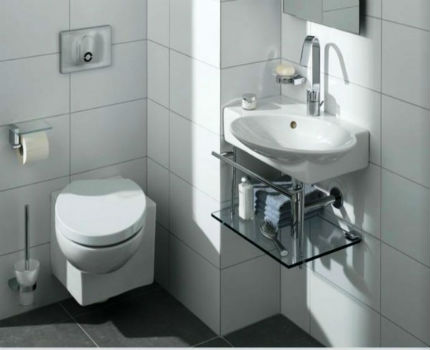
You can use two installation options:
- Purchase a corner mounting module.
- Choose a standard frame, however, purchase special mounts for its placement in the corner.
Similar structures at the junction of the walls look airy and occupy a minimum of space.
On an island or under a window. This option allows you to optimally use the wall section under the window or zoning the room. For such placement, it is advisable to choose small frame systems whose height does not exceed 82 cm.
Line installation. In this case, a single installation design is installed, combining several plumbing items at once: toilet bowl, sink, bidet.

In this way, you can install all the necessary equipment at a time, designing the room in a single style.
Types of installation by design
It is customary to distinguish between two main types of similar structures, which differ not only in technical characteristics. But also in the nuances of installation.
No. 1. Block (mounted) model and its features
This is the simplest and most cost-effective installation system, but it has a significant limitation in use - it can only be installed on a bearing main wall. The design includes a plastic tank, mounting plates with anchors, a set of studs designed for fastening the toilet.
Installing a Block Installation
The hinged structure is placed in a niche made in the wall. When applying the frame, it is important to determine the height of the installation, and then in the right places mark the labels for installing the mount.
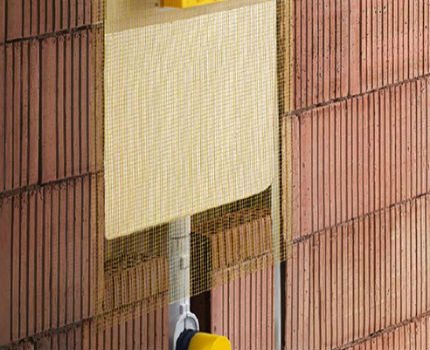
Holes are drilled with a puncher, where dowels are clogged, onto which the installation is hung with a screwed tank. After performing a reliability check on the installed gaskets, the drain tank is connected to the communications.
The pins necessary for hanging the bowl of the hygiene device are inserted into the pre-made holes. Then the space under the block is laid with a brick: if there are voids between the false and the main wall, the toilet will press on the partition, as a result of which its finish (for example, tiles) may crack.
The final stage is the sealing of the hole with a waterproof gypsum plasterboard (usually in two layers), in which a revision window is provided, which is closed by a panel with a drain button. The toilet is hung last, at the end of all installation work.
No. 2. Frame Installation Features
A more complex, versatile, costly option is the frame structure. This is a strong steel frame with a corrosion-resistant coating, to which the fittings are required, required for mounting the installation and plumbing fixtures hung on it.

A similar system can be installed in any room, regardless of the material of the walls and their strength. However, it should be borne in mind that the quality of the partitions directly affects the option of fasteners. With a bearing ceiling, it is better to prefer wall mounting, in which all the load falls on the wall.
If you decide to place the installation on a plasterboard or foam block partition, it is advisable to choose the floor option: in this case, the frame is installed on special legs.
There is also a combined modification, which provides for fixing the model with four holes for both vertical and horizontal surfaces.
All frame installation systems with the help of legs are adjustable in height (about 20 cm), which is very convenient, since this function allows you to install the device at the required distance from the floor covering.
You can also note the great functionality of such designs. When installing it, you can provide for the installation of a shelf or ledge in the wall.
Mounting frame structures
Initially, you should determine the place of attachment of the frame, which can be attached to the wall or mounted on the floor. At the same time, you need to determine the height at which the toilet will be located.
After that, the tank is installed. A water pipe is connected to it, connected to the inlet fitting.
You should not use flexible eyeliners, the life of which is much shorter than the period of service of the toilet and the drain tank.
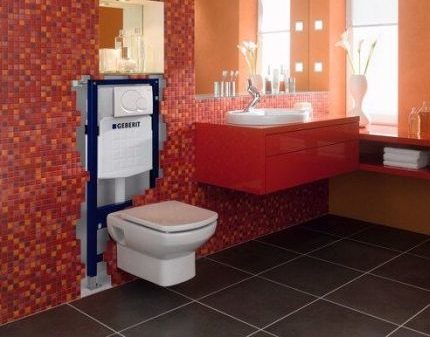
The sewer outlet of the toilet is connected to the riser using corrugation or directly. At the end of the procedure, it is important to check the strength of the connection by pouring about 3 liters of water.
The final step is to finish the installation with a double sheet of drywall (GKVL), in which the necessary holes are cut out, after which the drain button is mounted and the false wall is finished.
More information about the installation technologies of the block and frame system is written in this article.
Overall range of toilet installations
When choosing an installation, you must pay attention to its parameters. This is especially important if a specific location is already reserved for the installation of the system.
The standard version of block systems has the following dimensions:
- width - 50 cm;
- depth - 10-15 cm;
- height - 1 m.
A typical frame construction usually has the following parameters:
- width - 50-60 cm;
- depth - 15-30 cm;
- height - 0.8-1.4 m.
When choosing frame installations for placing plumbing under the window, it is better to give preference to lower modifications with a height of 80-82 cm. Low wide structures that reduce the load on the walls, it is advisable to use in houses with wooden partitions.
To better meet the needs of customers, many companies produce non-standard model modifications.
In the assortment of a German company TECE there is an installation with a depth of only 8 centimeters. A slightly wider version of 9 cm is released by the Spanish manufacturer Roca.
Miniature design 30 cm wide is offered by an Italian company Migliore, and in the size range of the Dutch company WiSA Excellent there is an option with a similar parameter of 38 cm.
The best manufacturers of hanging fixtures
Among the most popular brands producing toilet installations are Turkish Vitraspanish Roca, polish Cersanitfamous German companies Tec, Viega, GroheRussian brand IDDISrenowned swiss brand Geberit, a Dutch company WiSA Exellent, italian MiglioreCzech Alcaplast.
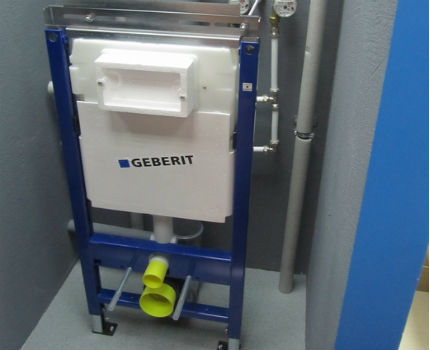
According to surveys of participants in relevant forums, the following five were determined top manufacturers suspended structures:
- The first place was taken by the company Geberit, producing installation systems with a unique seamless tank.
- The second is divided by the company Grohe/Viega.
- The third went to the German manufacturer Tec.
- Firms settled in the fourth Cersanit and Wisa.
- Fifth took the budget mark Alcaplast.
In addition to the durability and quality of the products, the respondents drew attention to the design of models, in particular, to the beauty of buttons. In their opinion, panels manufactured by companies are distinguished by special originality and variety. Tece, Geberit and Vierga.
When buying plumbing, it is important to remember that even high-quality devices can fail due to factors such as improper installation, poor water quality, violation of operating rules.
Tips Before Buying Attachments
For the installation of overhead plumbing, you must purchase the following set of components:
- Installation system. The choice of modification directly depends on the quality of the walls: the block one is suitable only for strong supporting structures, while the frame one is compatible with plasterboard or foam block partitions. An important point is the planned location of plumbing fixtures.
- Hanging (floor) bowl toilet bowl with the desired cover. When buying, you should definitely find out from the seller whether the kit includes fasteners and an adapter designed for mounting the flush elbow. In the case of a negative answer, they will have to be bought additionally (it is advisable to choose parts of the same company).
- Tank and key flushing must be purchased separately if the finished kit does not include such elements.
- Sound insulation gaskets. An important component that will provide additional sound insulation, eliminating the sounds of drained water.
After purchasing plumbing, it is necessary to check the components, checking their availability with the list in the instructions.
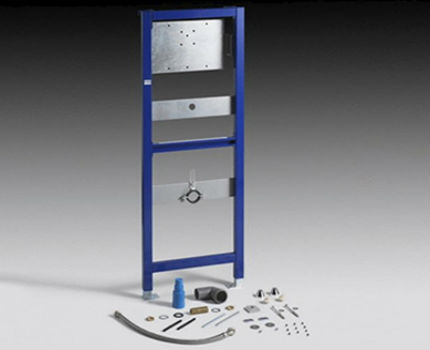
When choosing a model, you should also pay attention to the available additional functions, for example, to absorb unpleasant odors or the possibility of saving water. You must also ask the seller how commercially available components of this company are available if they have to be purchased separately.
Be sure to keep the warranty card for purchased products.
Four misconceptions about installing a toilet
Myth 1. Since all technical communications are located inside the system, in the case of the simplest repair installation or replacement of an individual component will have to completely destroy the false wall, damaging the cladding or other finish.
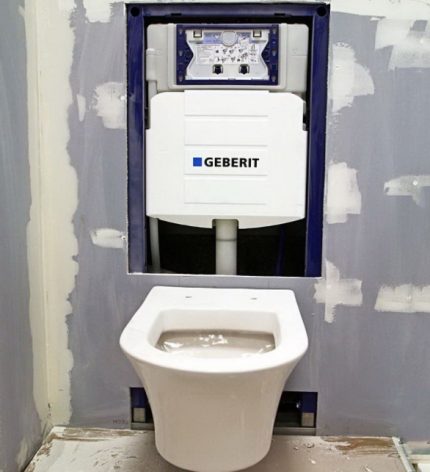
Rebuttal. Access to the drainage system is easy - through the inspection window, which opens when you remove the panel with a button for flushing. Such a constructive solution makes it easy to correct the shortcomings in the operation of the shutoff valve and other parts of the valve, and to replace them.
It is worth adding that the service life of a drain tank made of durable plastic, as a rule, is equal to the period of operation of the entire system.
Myth 2. If any component of the installation for the toilet breaks down, it will be difficult to purchase it on the open market.
Rebuttal. It is not difficult to find spare parts for the most popular models of hanging sanitary ware; they are widely represented in specialized stores. If in doubt, you can ask the seller in advance how much the details of a particular brand are available on the market.
Myth 3. Wall hung toilets are unreliable and fragile. It is unlikely that such plumbing is suitable for overweight people.
Rebuttal. This category of sanitary ware is mounted on a sturdy frame made of steel. The frame is built into the wall reliably, which ensures its strength and stability.Manufacturers of such products guarantee that they can withstand the weight of 200-400, and some models - even 800 kilograms.
Myth 4. To install a hanging toilet, a lot of space is required, since part of the usable area will be raised wall.
Rebuttal. Hanging plumbing is located directly against the wall, so the installation takes the place that usually takes the tank of a traditional model of a hygienic device.
When placing the structure in a niche with communications, it is possible to even slightly increase the free space of the toilet or bathroom.
Conclusions and useful video on the topic
In the video below, you can hear tips on choosing the installation for the toilet directly from a specialist:
Hanging toilets and other hygiene products combine reliability, convenience and attractive appearance. With their help, you can transform the interior of any sanitary room, giving it airiness and elegance.
There is something to supplement, or there were questions about the choice of installation for the toilet - you can leave comments on the publication. The comment form is in the bottom block.

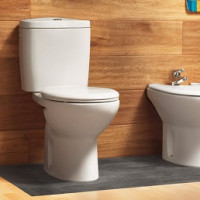 How to choose the right toilet: what to look before buying + manufacturers overview
How to choose the right toilet: what to look before buying + manufacturers overview 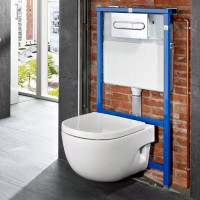 How to fix a toilet installation: popular breakdowns and how to fix them
How to fix a toilet installation: popular breakdowns and how to fix them 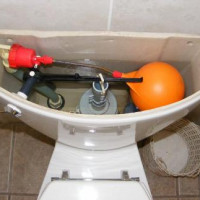 Flush mechanism for the toilet: device, principle of operation, an overview of various designs
Flush mechanism for the toilet: device, principle of operation, an overview of various designs 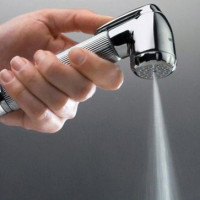 Hygienic shower for the toilet: a comparative overview of the designs and the nuances of the installation
Hygienic shower for the toilet: a comparative overview of the designs and the nuances of the installation 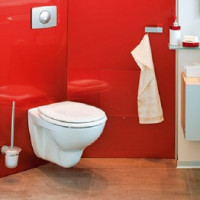 Corner installation for a toilet: selection tips and installation rules
Corner installation for a toilet: selection tips and installation rules 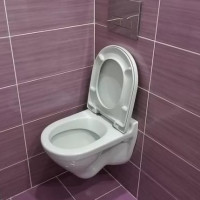 How to choose a hanging toilet: which is better and why + manufacturers overview
How to choose a hanging toilet: which is better and why + manufacturers overview  How much does it cost to connect gas to a private house: the price of organizing gas supply
How much does it cost to connect gas to a private house: the price of organizing gas supply  The best washing machines with dryer: model rating and customer tips
The best washing machines with dryer: model rating and customer tips  What is the color temperature of light and the nuances of choosing the temperature of the lamps to suit your needs
What is the color temperature of light and the nuances of choosing the temperature of the lamps to suit your needs  Replacement of a geyser in an apartment: replacement paperwork + basic norms and requirements
Replacement of a geyser in an apartment: replacement paperwork + basic norms and requirements
Recently made repairs in the bathroom and, accordingly, in the toilet. The room is small, and decided to choose a corner wall-hung toilet. Firstly, it really does not take up as much space as a regular one, and secondly, it looks interesting and modern. There are no problems with its installation, and there are not so many hassles, you just need to purchase special mounts. A bidet was installed next to him - a wife’s whim. We were satisfied with the repair. So for those who want to install such a toilet and are not sure - do not be afraid, everything is nowhere simpler.
A hanging toilet saves space. I myself was amazed at how much more compact an ordinary toilet bowl it looks with the same dimensions. It turned out to be easy to install, the main problem is the decoration. Because I wanted to have access to the pipes, then the false wall was made decorative so that it could be moved at any moment on my own. It cost me a pretty penny.
We want to make cabinets with a depth of 40 cm above the installation. The question is quite simple: to buy such an anchor length or not any installation will do (since the standard is done on cm 20)?